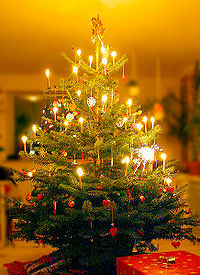Sinterklaas
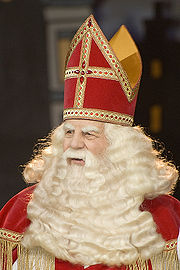
Sinterklaas
|
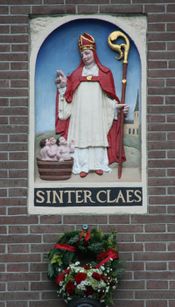
Sinter Claes depiction at a 16th-century house near the Dam in Amsterdam. Saint Nicholas is the patron saint of the capital of the Netherlands.
|

Zwarte Piet
|
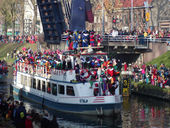
Sinterklaas and his Zwarte Piet helpers arriving by steamboat from Spain
|

A chocolate letter, typical Sinterklaas candy
|

The Feast of Saint Nicholas, by Jan Steen
|
Sinterklaas (also called Sint Nicolaas, de Goedheiligman or simply de Sint in Dutch []) and Saint Nicolas in French) is a traditional Winter holiday figure in the Netherlands, Belgium, Aruba, Suriname and Netherlands Antilles; he is celebrated annually on Saint Nicholas' eve (5 December) or, in Belgium, on the morning of 6 December. The feast celebrates the name day of Saint Nicholas, patron saint of Amsterdam, children and sailors. He is the basis of the mythical holiday figure of Santa Claus in the United States.
Saint Nicholas is also celebrated in the traditionally Germanic parts of France (North, Alsace, Lorraine), as well as in Luxembourg, Switzerland, Germany, Austria, Poland, Hungary, Croatia, Romania, Slovakia, Slovenia, the Czech Republic, and in the town of Trieste and in Eastern Friuli in Italy. Additionally, many Roman Catholics of Alsatian and Lotharingian descent in Cincinnati, Ohio, celebrate "Saint Nicholas Day" on the morning of 6 December. The traditions differ from country to country.
Contents |
History
The Sinterklaas feast celebrates the name day, 6 December, of Saint Nicholas (280–342), patron saint of children and sailors. Saint Nicholas was a bishop of Myra in present-day Turkey. In the 11th century, the saint's bones were taken and moved to southern Italy, an area then ruled by Spain, and relics and his fame spread throughout Europe. The Western Christian Church made his name day a Church holiday. In the north of France, he became the patron saint of school children, then mostly in church schools. The folk feast arose during the Middle Ages. In early traditions, students elected one of them as "bishop" on St. Nicholas Day, who would rule until December 28 (Innocents Day). They sometimes acted out events from the bishop's life. As the festival moved to city streets, it became more lively.[1]
In medieval times, the feast was both an occasion to help the poor, by putting money in their shoes (which evolved into putting presents in children's shoes) and a wild feast, similar to Carnival, that often led to costumes, a "topsy-turvy" overturning of daily roles, and mass public drunkenness. After the Protestant Reformation, England and Germany prohibited celebration of the saint; Netherlands also became a largely Protestant country following the Reformation, and the government abolished public celebrations in the 17th century, but people protested, including students in Amsterdam. The government allowed celebration within the family. In the nineteenth century, as shown below, the saint became more secularized.[1]
The modern tradition of Sinterklaas as a children's feast was likely confirmed with the illustrated children's book Sint Nicolaas en zijn knecht (Saint Nicholas and His Servant), written in 1850 by the teacher Jan Schenkman (1806–1863). He introduced the images of Sinterklaas' delivering presents by the chimney, riding over the roofs of houses on a gray horse, and arriving from Spain by steamboat, then an exciting modern invention. The book's ideas were incorporated by many across the Netherlands in their personal and communal celebrations. Schenkman also introduced the song "Zie ginds komt de stoomboot" ("See, there comes the steamboat"), still popular in the nation. In Schenkman's version, the medieval figures of the mock devil, which later changed to Oriental or Moorish helpers, was portrayed for the first time as black African and called Zwarte Piet (Black Peter).[1] He is a negro boy who accompanies Sinterklaas and helps him on his rounds (possibly derived from the Dutch colonial experience.) In late 20th and 21st century celebrations, numerous people dress as Zwarte Pieten in various cities across the Netherlands.[2]
In the Netherlands, Saint Nicholas' Eve (5 December) is the chief occasion for gift-giving during the Christmas season. The evening is called "sinterklaasavond" or "pakjesavond" ("presents evening"). In the Netherlands, children receive their presents on this evening; whereas in Belgium children put their shoe in front of the fireplace on the evening of 5 December, then go to bed, and find the presents around the shoes on the morning of the 6th.
Sinterklaas during World War II
In the lean times of the German occupation of the Netherlands (1940–1945), Sinterklaas nonetheless came to cheer everyone, not just children. Many of the traditional Sinterklaas rhymes written during those times[3] referred to current events. The Royal Air Force (RAF) was often celebrated. In 1941, for instance, the RAF dropped boxes of candy over the occupied Netherlands. A contemporary poem was the following:
- R.A.F. Kapoentje,
- Gooi wat in mijn schoentje,
- Bij de Moffen gooien,
- Maar in Holland strooien!
This is a variation of one of the best-known traditional Sinterklaas rhymes, with "R.A.F." replacing "Sinterklaas" in the first line (the two expressions have the same metrical characteristics), and in the third and fourth lines, the RAF is encouraged to drop bombs on the Moffen (slur for Germans, like "krauts" in English) and candy over the Netherlands. Many of the Sinterklaas poems of this time noted the lack of food and basic necessities, and the German occupiers having taken everything of value; others expressed admiration for the Dutch Resistance.[4]
Physical descriptions
Sinterklaas
Sinterklaas has a long red cape, wears a traditional white bishop's robe and red mitre, and holds a crosier, a long gold-coloured staff with a fancy curled top. He carries a big book that tells whether each individual child has been good or naughty in the past year. He traditionally rides a gray horse.
Zwarte Piet
Sinterklaas and his Black Peter usually carry a bag which contains candy for nice children and a roe, a chimney sweep's broom made of willow branches, used to spank naughty children. Some of the older Sinterklaas songs make mention of naughty children being put in the bag and being taken back to Spain. The Zwarte Pieten toss candy around, a tradition supposedly originating in Sint Nicolaas' story of saving three young girls from prostitution by tossing golden coins through their window at night to pay their father's debts.
Arrival
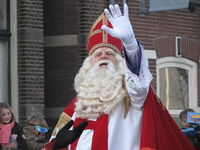

Sinterklaas traditionally arrives in the Netherlands each year in mid-November (usually on a Saturday) by steamboat from Spain. Some suggest that gifts associated with the holy man, such as mandarin oranges, led to the misconception that he must have been from Spain. He parades through the streets on his gray horse Amerigo, welcomed by cheering and singing children.[5] This event is broadcast live on national television in the Netherlands and Belgium. His Zwarte Piet assistants throw candy and small, round, gingerbread-like cookies, either "kruidnoten" or "pepernoten," into the crowd. The children welcome him by singing traditional Sinterklaas songs. Sinterklaas visits schools, hospitals and shopping centers. After this arrival, all towns with a dock usually celebrate their own "intocht van Sinterklaas" (arrival of Sinterklaas). Local arrivals usually take place later on the same Saturday of the national arrival, the next Sunday (the day after he arrives in the Netherlands or Belgium), or one weekend after the national arrival. In places a boat cannot reach, Sinterklaas arrives by train, bus, horse, or even carriage.
Presents
Traditionally, in the weeks between his arrival and 5 December, before going to bed, children put their shoes next to the fireplace chimney of the coal-fired stove or fireplace. In modern times, they may put them next to the central heating unit. They leave the shoe with a carrot or some hay in it and a bowl of water nearby "for Sinterklaas' horse," and the children sing a Sinterklaas song. The next day they will find some candy or a small present in their shoes.
Typical Sinterklaas treats traditionally include: hot chocolate, mandarin oranges, pepernoten, letter-shaped pastry filled with almond paste or chocolate letter (the first letter of the child's name made out of chocolate), speculaas (sometimes filled with almond paste), chocolate coins and marzipan figures. Newer treats include kruidnoten (a type of shortcrust biscuit or gingerbread biscuits) and a figurine of Sinterklaas made of chocolate and wrapped in colored aluminum foil.
Poems can still accompany bigger gifts as well. Instead of such gifts being brought by Sinterklaas, family members may draw names for an event comparable to Secret Santa. Gifts are to be creatively disguised (for which the Dutch use the French word "surprise"), and are usually accompanied by a humorous poem which often teases the recipient for well-known bad habits or other character deficiencies.
Sinterklaas, Santa Claus, and Christmas
Sinterklaas is the basis for the North American figure of Santa Claus. It is often claimed that during the American War of Independence the inhabitants of New York City, a former Dutch colonial town (New Amsterdam) reinvented their Sinterklaas tradition, as Saint Nicholas was a symbol of the city's non-English past.[6] The name Santa Claus supposedly derived from older Dutch Sinte Klaas. But, the Saint Nicholas Society was not founded until 1835, almost half a century after the end of the war.[7] In a study of the "children's books, periodicals and journals" of New Amsterdam, the scholar Charles Jones did not find references to Saint Nicholas or Sinterklaas.[8] Not all scholars agree with Jones's findings, which he reiterated in a book in 1978;[9] Howard G. Hageman, of New Brunswick Theological Seminary, maintains that the tradition of celebrating Sinterklaas in New York existed in the early settlement of the Hudson Valley. He agrees that "there can be no question that by the time the revival of St. Nicholas came with Washington Irving, the traditional New Netherlands observance had completely disappeared."[10]
Irving's stories prominently featured legends of the early Dutch settlers, so while the traditional practice may have died out, Irving's St. Nicholas may have been a revival of that dormant Dutch strand of folklore. The Saint Nicholas Society of New York celebrates a feast on 6 December to this day. The town of Rhinebeck in Dutchess County, New York, which was founded by Dutch and German immigrants, has an annual Sinterklaas celebration. It includes Sinterklaas' crossing the Hudson River and a parade up to the center of town.[11]
During the Reformation in 16th-17th century Europe, many Protestants changed the gift bringer to the Christ Child or Christkindl (corrupted in English to Kris Kringle). Similarly, the date of giving gifts changed from December 5th or 6th to Christmas Eve.[12]
Notes
- ↑ 1.0 1.1 1.2 Temple Hauptfleisch, Shulamith Lev-Aladgem, Jacqueline Martin, Willmar Sauter, and Henri Schoenmakers, ed., Festivalising!: Theatrical Events, Politics and Culture, Amsterdam and New York: International Federation for Theatre Research, 2007, p. 291, accessed 16 Aug 2010
- ↑ Bas, Jan de (2003), Een mijter zonder kruis: Sint-Nicolaas in de protestantse pers 1945-2000, Verloren, pp. 127, ISBN 9789065507709, http://books.google.com/?id=gyBeHYkyqigC&pg=PA127
- ↑ Some of these were collected, published in 2009 by Hinke Piersma, a researcher at the Dutch Institute for War Documentation.
- ↑ Budde, Sjoukje (4 December 2008), "Hitler heeft den strijd gestart, maar aan ’t eind krijgt hij de gard", De Volkskrant (Amsterdam), http://www.volkskrant.nl/binnenland/article1103863.ece/Hitler_heeft_den_strijd_gestart%2C_maar_aan_t_eind_krijgt_hij_de_gard, retrieved 5 December 2008.
- ↑ "Sinterklaas Arrival--Amsterdam, the Netherlands", St. Nicholas Center, 2008, http://www.stnicholascenter.org/Brix?pageID=105.
- ↑ Saint Nicholas, Sinterklaas, Santa Claus
- ↑ "History of the Society", The Saint Nicholas Society of the City of New York, http://www.saintnicholassociety.org/history.htm, retrieved 5 December 2008
- ↑ Jones, Charles W., "Knickerbocker Santa Claus", The New-York Historical Society Quarterly XXXVIII (4).
- ↑ Charles W. Jones, Saint Nicholas of Myra, Bari, and Manhattan: Biography of a Legend (Chicago: U of Chicago P, 1978)
- ↑ Hageman, Howard G. (1979), "Review of Saint Nicholas of Myra, Bari, and Manhattan: Biography of a Legend", Theology Today (Princeton: Princeton Theological Seminary) 36 (3), http://theologytoday.ptsem.edu/oct1979/v36-3-bookreview15.htm, retrieved 5 December 2008.
- ↑ Sinterlaas in Rhinebeck
- ↑ Forbes, Bruce David, Christmas: a Candid History, University of California Press, 2007, ISBN 0520251040, pp. 68-79.
See also
- Culture of Belgium
- Culture of the Netherlands
- Saint Nicholas
- Santa Claus
|
||||||||
|
||||||||||||||||||||||
